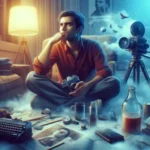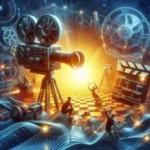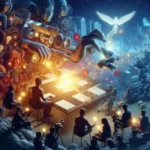Film noir, with its moody aesthetics and morally ambiguous characters, has long captivated audiences with its shadowy allure.
Emerging in the 1940s and 50s, this cinematic style painted a gritty portrait of post-war America, characterized by its stark contrasts and intricate narratives. However, as we step into the 21st century, the genre has undergone a fascinating evolution, reflecting contemporary societal issues while staying true to its roots. In this blog post, we will explore how modern filmmakers are reimagining the classic tropes of film noir, infusing fresh perspectives and innovative storytelling techniques. From the rise of neo-noir narratives that tackle themes of identity and technology to the influence of global cinema, we will uncover how the essence of film noir continues to resonate in today’s cultural landscape. Join us as we delve into the shadows and unveil the intriguing transformation of this timeless genre, revealing how it remains both relevant and captivating in the modern age.
1. Introduction to Film Noir: A Brief History

Film noir, a cinematic style characterized by its moral ambiguity, stark lighting, and complex narratives, first emerged in the early 20th century, primarily in the 1940s and 1950s. Rooted in the societal upheavals of post-World War II America, it reflected the disillusionment and anxiety of a generation grappling with the consequences of war, urbanization, and social change. Noir films often featured hard-boiled detectives, femme fatales, and a pervasive sense of gloom, drawing audiences into a world where the line between right and wrong was perpetually blurred.
The term “film noir” itself, which translates to “black film,” was coined by French critics who noticed a distinct pattern in American cinema that diverged from the classic hollywood glamor. This genre thrived on low-key lighting, deep shadows, and a restricted color palette that emphasized the psychological turmoil of its characters. Iconic films like “Double Indemnity,” “The Maltese Falcon,” and “Sunset Boulevard” became touchstones of this genre, showcasing gritty narratives filled with betrayal, crime, and existential despair.
As the decades passed, film noir began to evolve, giving rise to neo-noir—a modern interpretation that retained the genre’s core elements while incorporating contemporary themes and styles. Today, the legacy of film noir continues to influence filmmakers around the globe, with its aesthetic and narrative techniques permeating various genres, from thrillers to dramas. In this exploration of film noir’s evolution in the 21st century, we will delve into how modern filmmakers have reimagined this timeless genre, infusing it with fresh perspectives while paying homage to its storied past. The shadows may have shifted, but the compelling allure of film noir remains as potent as ever.
2. Defining Characteristics of Classic Film Noir
To fully appreciate the evolution of film noir in the 21st century, it’s essential to first explore the defining characteristics that set the classic genre apart. Originating in the shadows of the late 1940s and early 1950s, classic film noir is steeped in a distinct aesthetic and thematic depth that continues to influence filmmakers today.
At its core, classic film noir is characterized by its moody, atmospheric cinematography. The use of low-key lighting creates a stark contrast between light and shadow, often mirroring the moral ambiguity that permeates the narratives. Streets glisten with rain-soaked reflections, and the chiaroscuro effect generates a palpable tension, drawing viewers into a world fraught with danger and deception.
Narrative complexity is another hallmark of classic noir. These films often feature intricate plots filled with twists and turns, weaving together themes of crime, betrayal, and existential dread. The protagonists—often flawed antiheroes—navigate a labyrinth of deceit, fueled by their desires and haunted by their pasts. Their journeys often lead to an inevitable downfall, underscoring the genre’s exploration of fatalism and the darker aspects of human nature.
Moreover, film noir is punctuated by its unique character archetypes. The femme fatale, with her alluring charm and duplicitous intentions, stands as a symbol of both temptation and peril. Equally compelling are the weary detectives and morally ambiguous characters who find themselves ensnared in a web of intrigue, forcing audiences to grapple with their own perceptions of right and wrong.
Finally, classic film noir is steeped in a gritty realism that reflects the socio-political climate of its time. Post-war disillusionment, urban decay, and the complexities of post-World War II life are woven into the narratives, providing a rich backdrop that resonates with audiences on multiple levels. This blend of style, character, and thematic depth creates a tapestry of storytelling that continues to captivate and inspire, laying the groundwork for the innovative interpretations we see in 21st-century film noir.
As we delve deeper into the evolution of film noir, it becomes clear that these classic defining characteristics serve as both a foundation and a point of departure for contemporary filmmakers, who are reimagining the shadows in exciting and unexpected ways.
3. The Shift in Themes: From Pulp Fiction to Modern Morality

As film noir transitioned from its classic roots into the 21st century, the themes that once defined the genre underwent a significant transformation. In the mid-20th century, noir films often centered around the gritty narratives of hard-boiled detectives and femme fatales, steeped in the moral ambiguity of a post-war world. The archetypes of corruption, betrayal, and existential dread were prevalent, often framed within a pulp fiction aesthetic that reveled in the shadowy corners of society. However, as we moved into a new era, filmmakers began to explore more complex and nuanced themes, reflecting the shifting societal landscape and a richer understanding of human psychology.
Modern morality has emerged as a central theme in contemporary noir. Today’s narratives delve deeper into the internal struggles of characters, examining the moral dilemmas they face in a rapidly changing world. Unlike their predecessors, who often navigated clearly defined lines between good and evil, modern characters grapple with shades of gray—reflecting the complexities of identity, ethics, and personal responsibility. Films like “Nightcrawler” and “Gone Girl” illustrate this shift, showcasing protagonists whose motivations and actions challenge audiences to question their own moral compass.
Moreover, the influence of technology on modern storytelling cannot be overstated. The pervasive presence of social media and digital surveillance has introduced new layers of paranoia and deception, allowing filmmakers to explore themes of manipulation and the facades people maintain in their everyday lives. As a result, the noir of today embraces a multi-dimensional approach to its characters and narratives, portraying a world where the line between hero and villain is increasingly blurred.
In essence, the evolution of film noir in the 21st century reflects a broader cultural dialogue about morality, personal agency, and the impact of societal change. As audiences become more attuned to the complexities of human experience, noir’s capacity to adapt and resonate with contemporary themes ensures its enduring relevance in the cinematic landscape.
4. Visual Aesthetics: How Cinematography Has Evolved
The visual aesthetics of film noir have undergone a remarkable transformation in the 21st century, breathing new life into the genre while honoring its shadowy roots. Traditional film noir, characterized by its stark black-and-white contrasts, low-key lighting, and dramatic framing, set the stage for a world steeped in moral ambiguity and existential dread. However, contemporary filmmakers have embraced technological advancements, allowing for a fresh reinterpretation of these classic visual elements.
Today’s cinematography in film noir-inspired works often incorporates a rich color palette, utilizing color grading techniques to create an atmosphere that resonates with the emotional weight of the narrative. Films like *Sin City* and *Blade Runner 2049* exemplify this evolution, merging vibrant hues with shadowy undertones to evoke a sense of unease and tension that is both familiar and innovative. The use of digital cinematography has also opened new avenues for creative expression, enabling filmmakers to experiment with depth of field and dynamic camera movements that were previously limited by the technical constraints of film.
Moreover, the rise of streaming platforms has led to a resurgence of the noir aesthetic in episodic storytelling, allowing for more nuanced character development while maintaining the genre’s signature style. Series like *True Detective* and *The Night Of* utilize meticulous cinematography to create immersive environments that draw viewers into their morally complex worlds, blending traditional noir tropes with contemporary themes.
As filmmakers continue to push the boundaries of visual storytelling, the evolution of cinematography in film noir serves as a testament to the genre’s enduring legacy. By melding cutting-edge technology with the foundational elements that defined classic noir, the 21st century has given rise to a new era of visual aesthetics that captivates audiences and invites them to explore the depths of human nature through a modern lens.
5. The Role of Technology: Digital Filmmaking and Noir

The landscape of film noir has experienced a profound transformation in the 21st century, largely driven by advancements in technology and the rise of digital filmmaking. This evolution has not only expanded the possibilities of visual storytelling but has also reshaped the very essence of what noir can be.
Digital cameras, with their ability to capture stunning visuals in low-light conditions, have revitalized the moody, atmospheric aesthetics that are hallmarks of classic noir. Filmmakers can now experiment with chiaroscuro lighting in ways that were once limited by the constraints of film stock and lighting equipment. The result is a rich tapestry of shadow and light that enhances the psychological tension inherent in noir narratives. With tools like color grading software, directors can manipulate the palette of their films, creating an even more immersive and stylized experience that pays homage to the genre’s roots while pushing its boundaries.
Moreover, technology has democratized filmmaking, allowing a new generation of creators to explore noir themes and narratives. Independent filmmakers with access to affordable digital equipment can now craft stories that resonate with contemporary audiences, often infusing traditional noir tropes with fresh perspectives. This has led to a resurgence of stories reflecting modern anxieties—be it in the realms of technology, surveillance, or social disintegration—while still maintaining that quintessential noir feel.
The rise of streaming platforms has also played a crucial role in this evolution. With the ability to reach global audiences, filmmakers can create more experimental and niche works that may not have found a place in traditional cinema. Series such as “True Detective” and films like “Nightcrawler” showcase how noir can be reinterpreted through modern lenses, tackling current societal issues while retaining the genre’s signature style of moral ambiguity and existential dread.
In this digital age, the role of technology in film noir is not merely about aesthetics; it is about redefining the genre itself. As filmmakers harness the power of digital tools to tell their stories, they breathe new life into the shadows, ensuring that film noir continues to evolve and resonate in a world that is constantly changing.
6. Contemporary Influences: The Impact of Global Cinema
In the 21st century, the evolution of film noir has been significantly shaped by the diverse tapestry of global cinema. As filmmakers across the world draw inspiration from the classic elements of noir—its moody aesthetics, morally ambiguous characters, and intricate plots—they simultaneously infuse their narratives with unique cultural contexts and contemporary issues, creating a rich dialogue between the past and the present.
One of the most notable influences can be traced to the rise of international cinema, where filmmakers from countries such as South Korea, India, and France have reimagined the noir genre through their distinct lenses. South Korean cinema, for example, has embraced the psychological depth and stylistic flair of noir, as seen in films like “Memories of Murder” and “The Chaser.” These films not only echo the classic tropes of suspense and intrigue but also incorporate social commentary on issues like corruption and class disparity, resonating deeply with modern audiences.
Similarly, Indian filmmakers are weaving noir elements into their narratives, blending them with local storytelling traditions. The burgeoning genre of Bollywood thrillers often showcases dark themes and complex characters, reflecting the societal challenges faced in contemporary India. This synthesis of noir’s stylistic traits with regional flavors results in a compelling viewing experience that honors the genre’s roots while pushing its boundaries.
Moreover, the digital age has democratized filmmaking, allowing voices from underrepresented regions to share their stories. Streaming platforms have become the new breeding grounds for noir-inspired content, offering a plethora of films that explore the shadows of urban life, crime, and moral ambiguity from a global perspective. The accessibility of these platforms means that audiences are now more exposed to diverse interpretations of noir, leading to a broader appreciation for the genre’s versatility.
As we traverse this cinematic landscape, it becomes clear that contemporary influences are not merely adding layers to the film noir aesthetic; they are redefining its essence. By integrating cultural narratives and modern-day dilemmas, today’s filmmakers are not only keeping the spirit of noir alive but are also expanding its relevance in a rapidly changing world. The result is a dynamic evolution of film noir that reflects a global society grappling with its shadows, inviting audiences to engage with both timeless themes and fresh perspectives.
7. Notable Modern Film Noir Directors

As the allure of film noir continues to resonate with audiences, a new generation of directors has emerged, breathing fresh life into the genre while paying homage to its roots. These notable modern film noir directors deftly blend the classic elements of suspense, moral ambiguity, and stunning visual compositions with contemporary storytelling techniques, creating films that are both nostalgic and innovative.
One such director is **David Fincher**, whose works like “Se7en” and “Gone Girl” encapsulate the gritty realism and psychological tension that define noir. Fincher’s meticulous attention to detail and mastery of atmosphere draw viewers into worlds filled with dark secrets and complex characters, instantly immersing them in a narrative that feels both timeless and immediate.
Another prominent figure is **Nicolas Winding Refn**, known for his visually striking films like “Drive” and “Only God Forgives.” Refn’s unique style is characterized by its minimalist dialogue and lush cinematography, crafting a dreamlike quality that often masks the violent undercurrents of his stories. His ability to evoke emotion through stark visuals and haunting soundtracks underscores the existential themes that are hallmarks of the noir tradition.
**The Coen Brothers**, with their film “No Country for Old Men,” have also made significant contributions to the modern noir landscape. Their signature blend of dark humor and moral complexity creates a narrative that is both compelling and unsettling. The film’s relentless tension, combined with its exploration of fate and chance, exemplifies how classic noir themes can be reinterpreted for contemporary audiences.
Lastly, **Rian Johnson**, with films like “Brick” and “Knives Out,” showcases how the noir aesthetic can be seamlessly integrated into different genres. His innovative narratives and sharp dialogue breathe new life into the genre while retaining its core elements of intrigue and deception. Johnson’s work demonstrates that the essence of film noir can be adapted and evolved, proving that its themes remain relevant in our contemporary cultural landscape.
These directors, among others, are not merely replicating the past; they are actively redefining what film noir means in the 21st century. By infusing their unique visions and contemporary sensibilities into the genre, they ensure that film noir continues to captivate audiences, proving that even in the shadows, creativity can flourish.
8. Case Studies: Key Films That Redefine Noir in the 21st Century
In the 21st century, film noir has witnessed a remarkable evolution, adapting to contemporary themes while retaining the genre’s iconic stylistic elements. This transformation is vividly illustrated in several key films that not only pay homage to classic noir but also redefine its boundaries, exploring new psychological and societal landscapes.
One prominent example is **”Blade Runner 2049″** (2017), directed by Denis Villeneuve. This sequel to the iconic 1982 film serves as a profound meditation on identity and humanity set against a dystopian backdrop. With its stunning cinematography by Roger Deakins, the film bathes its characters in contrasting light and shadow, echoing the visual language of traditional noir while incorporating futuristic elements. The protagonist, K, navigates a world filled with moral ambiguity, embodying the classic noir anti-hero who grapples with existential dilemmas in an era dominated by technology and artificial intelligence.
Another significant entry is **”Gone Girl”** (2014), directed by David Fincher. This psychological thriller subverts the traditional noir narrative by centering on the complexities of marriage and media manipulation. The film’s intricate plot twists and darkly flawed characters mirror the classic femme fatale archetype, with Amy Dunne portrayed by Rosamund Pike as a modern embodiment of this trope. Fincher’s keen attention to detail and atmospheric tension elevate the film to a modern noir masterpiece, probing themes of deception, obsession, and the darker facets of human nature.
**”Sin City”** (2005), directed by Frank Miller and Robert Rodriguez, boldly reimagines noir through a hyper-stylized lens. Adapting Miller’s graphic novels, the film is a visual feast of stark black and white imagery punctuated by splashes of color, drawing direct inspiration from the comic book aesthetic. The intertwining narratives of crime and vengeance pay tribute to the genre’s roots while expanding its parameters, showcasing a gritty, exaggerated world that feels both familiar and refreshingly new.
Lastly, **”The Night Of”** (2016) stands out as a miniseries that encapsulates the essence of modern noir. This intricate crime drama delves deep into the criminal justice system, exploring themes of prejudice, morality, and the consequences of a single decision. With its moody cinematography and complex characters, “The Night Of” immerses viewers in a narrative that reflects the pervasive darkness of contemporary society, echoing the existential despair often found in classic noir.
These films represent just a glimpse into the rich landscape of 21st-century noir. Each one illustrates how the genre continues to evolve, reflecting modern anxieties and societal changes while maintaining the distinctive traits that have long captivated audiences. As filmmakers embrace new narratives and techniques, they forge a path for noir that resonates with the complexities of our time, ensuring that the shadows of the past remain relevant in the cinematic present.
9. The Femme Fatale Reimagined: Gender Dynamics in New Noir
The archetype of the femme fatale has long been a cornerstone of film noir, embodying the complex interplay between allure and danger, seduction and betrayal. In the 21st century, this character has undergone a profound transformation, reflecting the shifting gender dynamics and societal norms of our time. No longer confined to the seductive vixen of classic noir, today’s femme fatale is multifaceted, often portrayed as a character grappling with her own agency and moral complexities.
Modern interpretations of the femme fatale challenge traditional narratives, presenting women who are not merely objects of desire but active participants in their own stories. These characters navigate the murky waters of power and vulnerability, often subverting expectations by wielding their sexuality as a tool for empowerment rather than manipulation. For instance, films like “Gone Girl” and “The Girl with the Dragon Tattoo” introduce protagonists who defy the simplistic label of “dangerous woman,” instead offering rich, textured portrayals that explore themes of revenge, trauma, and resilience.
Furthermore, the reimagined femme fatale often engages in a dialogue with male characters that highlights the shifting power dynamics between the sexes. No longer is she the sole architect of her partner’s downfall; rather, she exists within a broader context of societal expectations and gender roles, prompting audiences to reconsider their preconceived notions of femininity and morality. This evolution invites viewers to empathize with her struggles, making her both a captivating figure and a reflective lens through which to examine contemporary issues of gender equality and empowerment.
As filmmakers continue to push the boundaries of the noir genre, the femme fatale remains an essential symbol of intrigue and complexity. Her evolution mirrors the broader conversation around gender in our society, serving as a reminder that the shadows of the past can illuminate new paths forward. In this reimagined landscape, the allure of the femme fatale persists, inviting audiences to explore the depths of her character while challenging them to redefine their understanding of power, sexuality, and identity in the modern world.
10. Noir in Television: The Rise of Neo-Noir Series
As we step into the 21st century, the shadows of classic film noir have found a new home in the realm of television, giving rise to a vibrant wave of neo-noir series that captivate audiences with their intricate storytelling and moral ambiguity. This evolution reflects a significant shift in how we consume narratives, allowing for deeper character development and more nuanced plots that were often constrained by the traditional film format.
In recent years, shows like “True Detective,” “Fargo,” and “The Night Of” have emerged, each weaving a rich tapestry of suspense, psychological complexity, and dark aesthetics reminiscent of their cinematic predecessors. These series embrace the quintessential elements of noir—complex antiheroes, femme fatales, and moral decay—while also infusing contemporary issues such as systemic corruption, mental health struggles, and societal disillusionment.
The episodic nature of television allows for a slow burn, drawing viewers into a web of intrigue that unfolds over several hours, rather than the brief escapism of a two-hour film. This format enables creators to explore the depths of their characters, showcasing their flaws and vulnerabilities, while maintaining the gripping tension that keeps audiences glued to their screens.
Moreover, the visual style of neo-noir series pays homage to the shadows and stark contrasts of classic noir, often employing moody cinematography and atmospheric soundtracks to evoke a sense of foreboding. This intentional aesthetic choice serves to not only enhance the narrative but also to evoke nostalgia for the genre’s roots.
As streaming platforms proliferate, the accessibility of these neo-noir series has expanded their reach, allowing diverse voices to contribute to the genre. New creators are infusing their unique cultural perspectives into the noir formula, resulting in a richer and more varied landscape that challenges and reinvents traditional tropes.
In this new golden age of television, film noir’s evolution into neo-noir series demonstrates its enduring relevance, proving that the shadows of the past can still illuminate the complexities of the human experience today. As viewers, we are invited to journey through these dark narratives, confronting our own moral dilemmas and the ever-blurring lines between right and wrong, all while enjoying the thrill of a well-crafted mystery.
11. The Intersection of Noir and Other Genres
The intersection of noir and other genres in the 21st century has breathed fresh life into the traditional elements of classic film noir, creating a rich tapestry that reflects contemporary society’s complexities. Filmmakers are no longer confined to the rigid frameworks of the past; instead, they are weaving noir’s signature themes—moral ambiguity, psychological depth, and atmospheric tension—into a diverse array of narratives.
Consider the burgeoning genre of neo-noir, where directors infuse elements of science fiction, horror, or even romantic comedy into the fabric of their stories. Films like “Blade Runner 2049” showcase an existential quest within a dystopian future while maintaining the haunting visual style and moral dilemmas that define noir. Similarly, the chilling undertones of horror have found a home in recent thrillers, such as “Gone Girl,” where the psychological manipulation and betrayal resonate with the classic noir sensibility, leaving audiences on the edge of their seats.
Television series have also embraced this genre-blending approach. Shows like “True Detective” and “Fargo” incorporate noir’s dark storytelling, but also infuse elements of thriller and dark comedy, creating a more complex narrative landscape. The use of richly developed characters and intricate plots allows for a deeper exploration of the human condition, all while maintaining the tension and suspense synonymous with noir.
Moreover, the influence of social commentary in modern noir cannot be overlooked. Filmmakers are increasingly addressing contemporary issues like systemic injustice, gender dynamics, and mental health, making noir relevant to today’s audiences. This evolution not only honors the legacy of classic noir but also invites new interpretations and discussions. By transcending traditional boundaries, the intersection of noir with other genres enriches the narrative landscape, creating a genre that is both timeless and timely, as it continues to evolve with the world around it.
12. Audience Reception: How Modern Viewers Interpret Noir
The evolution of film noir in the 21st century isn’t just a stylistic shift; it’s a profound transformation in how modern audiences interpret and engage with the genre. In an age dominated by the rapid dissemination of information and an ever-changing cultural landscape, contemporary viewers bring diverse experiences and expectations to the noir narrative.
Gone are the days when noir was merely defined by its moody cinematography and hard-boiled protagonists. Today, audiences are increasingly attuned to the nuances of storytelling, seeking deeper emotional connections and social commentary embedded within the dark, textured worlds of noir. The classic themes of betrayal, moral ambiguity, and existential dread still resonate, but they are now often intertwined with contemporary issues such as gender dynamics, racial identity, and the complexities of modern technology.
For instance, films like **”Gone Girl”** and **”Nightcrawler”** have redefined traditional noir archetypes, placing women and anti-heroes in roles that challenge the genre’s historical confines. Viewers relish unraveling these intricate characters, interpreting their actions through the lens of current societal norms and personal experiences. This shift has sparked discussions around the portrayal of villainy and virtue, prompting audiences to examine their own moral compasses in a world where lines between right and wrong are increasingly blurred.
Moreover, the rise of streaming platforms has democratized access to noir. Classic films and modern reinterpretations can be consumed in tandem, allowing audiences to draw parallels and contrasts between eras. Noir’s visual and thematic motifs are now being explored beyond the silver screen, influencing everything from graphic novels to video games, thereby broadening the genre’s appeal and interpretations.
As modern viewers engage with noir, they do so with a keen awareness of its historical context and its evolution. They are not just passive consumers but active participants in a dialogue about the genre’s relevance. This dynamic exchange gives rise to fresh interpretations that honor noir’s roots while propelling it into uncharted territories, ensuring that its shadowy allure remains potent in the contemporary imagination. In this ongoing conversation, the legacy of film noir continues to thrive, adapting and reinventing itself to captivate new generations of viewers who appreciate its complexity and depth.
13. The Future of Film Noir: Trends to Watch
As we delve into the future of film noir, we find ourselves at an intriguing crossroads where tradition meets innovation. The genre, known for its moody aesthetics, morally ambiguous characters, and gripping narratives, is evolving in response to contemporary societal concerns and advancements in technology. Here are some key trends to watch as film noir steps into the 21st century.
**1. The Rise of Neo-Noir:**
While classic film noir often focused on the post-war disillusionment of the 1940s and 50s, neo-noir is adapting these themes to reflect modern anxieties. Filmmakers are infusing contemporary issues—such as political corruption, digital privacy, and systemic inequality—into their narratives. Expect to see stories that tackle the complexities of life in a tech-driven society, where shadows are cast not just by physical characters, but by algorithms and surveillance.
**2. Diverse Perspectives:**
The traditional noir narrative often centered on a specific archetype: the hard-boiled detective or the femme fatale. However, the future of film noir is poised to include a broader array of voices and perspectives, highlighting underrepresented narratives. Women and people of color are stepping into lead roles, bringing fresh interpretations to the genre and challenging preconceived notions of morality and crime.
**3. Blurring Genre Lines:**
Film noir is increasingly intertwining with other genres, such as horror, science fiction, and thriller. This genre-blending creates a captivating tapestry of storytelling possibilities. Films that incorporate noir elements within fantastical settings or psychological thrillers are gaining traction, allowing for experimentation with tone and style. The traditional noir aesthetic of shadows and stark contrasts may coexist with vibrant colors and surreal landscapes, expanding the visual language of the genre.
**4. Streaming Revolution:**
The rise of streaming platforms has transformed how audiences consume film. This shift is giving filmmakers the freedom to explore darker, more intricate narratives that may not fit the conventional mold of mainstream cinema. Limited series and anthologies allow for deeper character development and extended storytelling, providing an opportunity to create a rich, immersive experience reminiscent of classic noir but tailored for modern viewers.
**5. Embracing Technology:**
As technology continues to influence filmmaking, expect to see innovative uses of virtual reality, augmented reality, and interactive storytelling in future noir projects. These advancements can transport audiences directly into the heart of the mystery, allowing them to experience the tension and intrigue firsthand. The use of digital media and social platforms for storytelling and promotion will also reshape how noir narratives engage with viewers, creating immersive experiences that extend beyond the screen.
In summary, the future of film noir is as enigmatic and layered as its narratives. As filmmakers continue to push boundaries while honoring the genre’s roots, audiences can look forward to a new wave of noir that reflects the complexities of our contemporary world—one that invites us to peer into the shadows, question morality, and ultimately, seek the truth hidden within the darkness.
14. Conclusion: The Enduring Legacy of Film Noir
In the flickering glow of cinema, the legacy of film noir continues to cast an indelible shadow over modern storytelling. Originating in the 1940s and 50s, film noir painted a world rife with moral ambiguity, existential dread, and complex characters navigating a landscape of crime and corruption. This genre’s hallmark aesthetics—gritty urban settings, stark contrasts of light and shadow, and the haunting presence of femme fatales—have not only influenced filmmakers of the past but have also woven themselves into the very fabric of contemporary cinema.
As we stand in the 21st century, the evolution of film noir is palpable. Today’s filmmakers are reinterpreting these classic themes through innovative lenses, blending traditional noir elements with modern narratives that reflect current societal issues. From the rise of neo-noir films that explore the psychological complexities of their characters to television series that embrace noir’s stylistic and thematic nuances, the genre has proven remarkably adaptable to the changing tides of culture and technology.
Moreover, the digital age has breathed new life into film noir, allowing for a resurgence in its aesthetic through streaming platforms and independent cinema. The accessibility of filmmaking tools has empowered a new generation of directors to experiment with noir’s visual language, creating fresh works that resonate with audiences seeking depth in storytelling. The genre’s influence can be seen in the narratives of crime dramas, thrillers, and even animated features, proving that the essence of noir—its exploration of the human condition, moral dilemmas, and the darker sides of life—remains relevant and compelling.
Ultimately, the enduring legacy of film noir lies in its ability to provoke thought and evoke emotion. It serves as a mirror reflecting the complexities of our own lives, urging us to confront the shadows that lurk in our society and within ourselves. As we look to the future, film noir will undoubtedly continue to evolve, inspiring filmmakers and captivating audiences, while reminding us that some stories, no matter how dark, are timeless in their exploration of the human experience.
15. Recommended Viewing: Essential Modern Noir Films
As we delve into the captivating world of modern noir, it’s essential to showcase films that not only pay homage to the classic elements of the genre but also innovate and redefine its boundaries for contemporary audiences. Here’s a curated list of essential modern noir films that have emerged in the 21st century, each offering a unique twist on the archetypal themes of crime, moral ambiguity, and existential dread.
1. **”Sin City” (2005)** – Directed by Frank Miller and Robert Rodriguez, this visually stunning adaptation of Miller’s graphic novels embodies the essence of noir with its striking black-and-white aesthetic, punctuated by splashes of color. The interwoven stories of love, betrayal, and violence showcase a gritty underworld that feels both timeless and shockingly fresh.
2. **”Zodiac” (2007)** – David Fincher’s meticulous examination of the infamous Zodiac Killer case presents a haunting portrayal of obsession and the quest for truth. With its atmospheric cinematography and a chilling score, this film immerses viewers in a world where the lines between justice and madness blur.
3. **”Drive” (2011)** – Nicolas Winding Refn’s “Drive” reinterprets the noir narrative through the lens of a stylish, minimalist thriller. Ryan Gosling’s enigmatic character navigates a dangerous underbelly of Los Angeles, where love and violence collide. The film’s synth-heavy soundtrack and striking imagery create an intoxicating mood that lingers long after the credits roll.
4. **”Gone Girl” (2014)** – Another masterpiece from David Fincher, this film adapts Gillian Flynn’s gripping novel to explore the dark depths of marriage and media manipulation. With its razor-sharp dialogue and unpredictable plot twists, “Gone Girl” embodies the psychological complexity often found in classic noir, leaving audiences questioning the nature of truth and deception.
5. **”Nightcrawler” (2014)** – Dan Gilroy’s “Nightcrawler” dives into the morally ambiguous world of freelance crime journalism. Jake Gyllenhaal’s portrayal of Lou Bloom, a driven yet disturbing character, highlights the lengths one will go for success in a cutthroat industry. The film’s eerie atmosphere and sharp social commentary make it a standout in the modern noir landscape.
6. **”The Nice Guys” (2016)** – A refreshing blend of humor and noir, this film directed by Shane Black revisits the buddy-cop trope with a playful twist. Set in 1970s Los Angeles, it juxtaposes gritty crime with comedic elements, delivering a lighthearted yet engaging narrative that still captures the essence of the genre.
7. **”Blade Runner 2049″ (2017)** – As a sequel to the iconic “Blade Runner,” Denis Villeneuve’s film expands the original’s philosophical inquiries into identity, memory, and humanity. With its stunning visuals and haunting score, it melds sci-fi with noir to explore themes of isolation and existential despair in a dystopian future.
These films exemplify the evolution of noir in the 21st century, reflecting contemporary societal issues while remaining grounded in the genre’s rich traditions. Whether you’re a seasoned noir enthusiast or a newcomer to the genre, these selections are sure to leave a lasting impression and spark thoughtful discussions about the nature of morality, identity, and human connection. Grab some popcorn, dim the lights, and immerse yourself in these modern classics that breathe new life into the shadows of film noir.
As we conclude our exploration of film noir’s evolution in the 21st century, it’s clear that this genre continues to captivate and inspire filmmakers and audiences alike. By reimagining its classic elements—dark aesthetics, morally ambiguous characters, and intricate plots—contemporary creators are breathing new life into the shadows that once defined this cinematic style. Whether through innovative storytelling techniques, modern social commentary, or the blending of genres, today’s film noir resonates with the complexities of our current world. As you revisit the films discussed in this post or discover new entries in the genre, we invite you to embrace the allure of the noir aesthetic and ponder how these haunting tales reflect not only the human experience but also the ever-evolving landscape of cinema. Thank you for joining us on this journey through the shadows; we look forward to seeing where these captivating narratives will lead us next.






